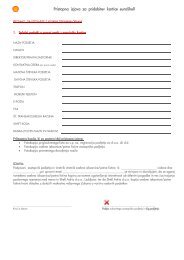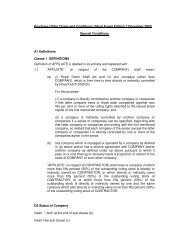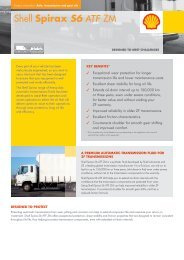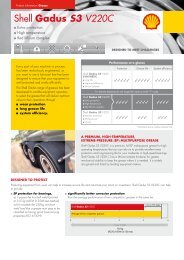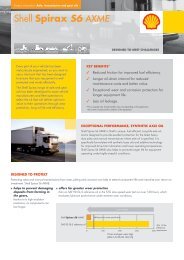OBEN GAS DEVELOPMENT PROJECT
OBEN GAS DEVELOPMENT PROJECT
OBEN GAS DEVELOPMENT PROJECT
You also want an ePaper? Increase the reach of your titles
YUMPU automatically turns print PDFs into web optimized ePapers that Google loves.
Chapter One Introduction, Administrative & Legal Framework<br />
Federation of Nigeria, Edict No 3 of January, 1994 as enacted by Military Administrator of Edo State of<br />
Nigeria to establish the Edo State Environmental Protection Agency (ESEPA), now State Ministry of<br />
Environment. They are important stakeholders in the Western Domestic Gas Supply Project/West<br />
African Gas Pipeline (WDGSP/WAGP) at Oben Field<br />
1.4.11 Public Health Law:<br />
The public health Law- CAP 103 of the Laws of Nigeria<br />
The public Health Order 47 of 1950 was amended to Public Health Law Cap 103 in October 1963. The<br />
law prohibits any act that may lead to the destruction of or cause injury to any human being in any LGA.<br />
Relevant sections are:<br />
Part 1 subsection 7 (d, h, k, l and n) and<br />
Part ll on sanitation sections 42, 45, 46, 48, and 52<br />
1.4.12 International Laws and Regulations<br />
Nigeria is signatory to several laws, treaties and regulations that govern the environment.<br />
Among these are:<br />
(i) World Bank Guidelines on Environmental Assessment {EA} (1991)<br />
(ii) International Union for Conservation of Nature and Natural Resources (IUCN) Guidelines<br />
(iii) Convention on the Migratory Species of Wild Animals (Bonn Convention)<br />
(iv) Convention of Biological Diversity<br />
(v) Convention Concerning the Protection of the World Cultural an National Heritage Sites (World<br />
Heritage Convention) and<br />
(v) Basel Convention on the Control of Trans-boundary Movements of Hazardous Wastes and their<br />
Disposal.<br />
(vi) United Nations Framework Convention on Climate Change (1992)<br />
1.4.13 World Bank Guidelines on Environmental Assessment {EA} (1991)<br />
The World Bank requires the execution of an EIA on a proposed industrial activity by a borrower as a<br />
pre-requisite for granting any financial assistance in form of loans. Details of World Bank’s EIA<br />
procedures and guidelines are published in the Bank’s EA Source Book vols. I -III of 1991. Potential<br />
issues considered for EA in the upstream oil and gas industry include the following:<br />
• Biological Diversity<br />
• Coastal and Marine Resources Management<br />
• Cultural Properties<br />
• Hazardous and Toxic Materials and<br />
• International waterways.<br />
1.4.14 International Union for Conservation of Nature and Natural Resources<br />
(IUCN) Guidelines (1948/1956)<br />
The IUCN in conjunction with the Oil Industry International Exploration and Production Forum presented a set<br />
of guidelines for oil and gas exploration and production in mangrove areas. These guidelines are aimed at<br />
conservation of mangroves and enhancing the protection of marine ecosystems during E & P activities. The<br />
document also discusses the policy and principles for environmental management in mangrove areas as well<br />
as EIA procedures, Environmental Audit and Monitoring.<br />
1.4.15 Convention on the Conservation of Migratory Species of Wild Animals (Bonn Convention).<br />
(1979)<br />
The Bonn Convention concerns the promotion of measures for the conservation (including habitat<br />
conservation especially for endangered species listed in Bonn) and management of migratory species.<br />
1-7










